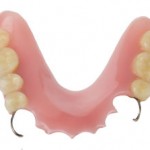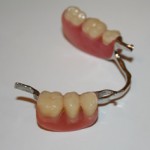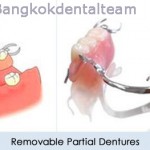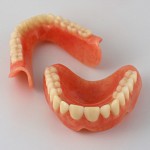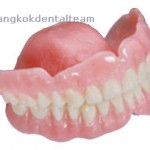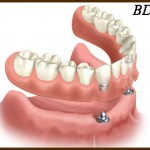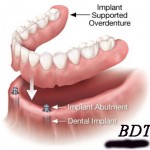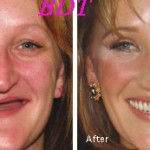Posts Tagged ‘ฟันปลอม’
-
Dental Implants
Q : What is a Dental Implant?
A: Different types of screw implants
An implant is an artificial root made from a biocompatible material that is implanted to replace lost teeth. Standard implants today are screw or cylinder form made from titanium.
Titanium is a unique metal: It can be incorporated in the bone without an intermediate layer. This intimate contact between bone and titanium is called osseointegration. Another advantage of titanium is it does not cause allergic reactions, rejection, nor inflammation of the oral mucosa. Because of its biocompatible qualities, titanium is broadly used for other medical implants, for example hips, knees, etc.
Normally, dental implants have a length of 6-15 mm and a diameter of 3-5 mm. On the market there are numerous companies producing implants, but only few systems are supported by scientific studies and long-term results
Q : How is an Implant Placed?
A: Careful planning is the first step preceding an implant operation. With help from x-rays and study models, the amount of bone is measured in length and width, so the ideal position for a suitable implant can be planned.
A : Implantation is a surgical intervention performed under sterile conditions that can take between 45-90 minutes. Implantation can be done without pain using local anesthesia. Nevertheless, the procedure can be stressful for some patients. For this reason, we offer treatment to be done under conscious sedation, using nitrous oxide (laughing gas) or other sedatives. The advantage is complete relaxation and comfort for the patient.
For larger operations, like bone augmentation, or for dental phobic patients, we can also offer general anesthesia. An expert team of anesthesiologists can accompany us within the Clinic St. Anna, or in our private practice.
After the gum tissue is numb, it is carefully opened. With a sequence of calibrated burs, the implant bed is prepared. To prevent overheating of the bone, preparation is done with sterile water cooling. The suitable implant is chosen and placed. The gum tissue is sutured over the implant and a temporary prosthesis or bridge is seated.
-
False Teeth (Dentures)
Dentures
Dentures
A denture replaces missing teeth and adjacent tissues. Unlike dental implants, a denture is removable.
They are made out of an acrylic resin and normally porcelain or metal will be added for additional structural support. If your dentures are well looked after, you will have a very natural looking smile. Your dentures will also help strengthen muscles controlling your expressions and you will be free of any speech problems which were caused by missing teeth. If you’ve lost, or are losing, all of your teeth a Complete Denture replacement could be the perfect solution for you.
Partial dentures
Partial dentures are placed to fill the gaps in your smile when only some of your teeth are missing. The dentures are anchored to your teeth with metal attachments. They maintain tooth alignment because they prevent your remaining teeth from shifting. They can also help prevent your loss of more teeth due to decay or gum disease.
Alternative materials : Acrylic base
– Affectionately known in dentistry as a “flipper”
– The pink plastic of the denture base is brittle acrylic, the same material used to make standard full dentures
– For several teeth missing, wrought wire clasps might be added and cured into the structure of the denture base for better retention.
– These are frequently fabricated even if the remaining teeth have existing decay or periodontal disease and their prognosis is doubtful.
– If later in the course of treatment some of the existing natural teeth are extracted for any reason, new false teeth can be added quickly to the partial, maintaining the patient’s appearance.
– In spite of the fact that they are considered a temporary solution, many people keep this type of appliance for many, many years, because as long as they are properly maintained, they look outwardly as good as the more expensive permanent appliances.
– One of the neatest tricks that a flipper can do is to act as an “immediate partial denture”. This means that the appliance can be made before the teeth are removed, and inserted immediately after the extraction of the offending teeth.
Cast metal framework Removable Partial Denture
– The framework is cast to fit the teeth. Since they sit on the teeth, as well as being attached to them, they are extremely stable and retentive.
– The metal framework does not contact the gums. Thus, as the gums resorb, this type of partial does not sink with them and rarely requires relines.
– The teeth have been altered slightly beforehand in order that the partial denture can rest upon them without interfering with the way the patient bites the teeth together.
– Modern frameworks are cast from an extremely strong alloy called chrome cobalt which can be cast very thin and are much less likely to break than the all plastic variety. They are also much less noticeable to the tongue.
Complete Dentures
These replace all of your teeth filling the entire upper or/and lower jaws. The level of comfort depends on your muscles, bones, tongue, and saliva. Upper Dentures are a little easier to adjust to.
The process of getting dentures requires several appointments, usually 1-2 weeks. Highly accurate impressions (molds) and measurements are taken and used to create your custom denture. Several “try-in” appointments may be necessary to ensure proper shape color and fit. At the final appointment, your dentist will precisely adjust and deliver the completed denture, ensuring a natural and comfortable fit.The appointment visit the dentist about 3-4 times.
Immediate Dentures :
Immediate Dentures are placed all at once. It may take several months for your bone and tissue to stabilize following the tooth extractions.
Over Dentures
These are similar to Complete Dentures but not all teeth are extracted and they use one or more natural teeth for their support. They also provide more stabilization during chewing than. On the down side they are more expensive and normally require more preparation.
- OverDentures with Implant
Advantages :
- Dentures provide a pleasant, natural looking smile.
- They are extremely durable.
- If well maintained, they should last from five to ten years.
- They can correct problems with speech to chewing, for many patients.
Disadvantages:
– Dentures take a little while to get used to.
– There is maintenance involved.
– In the first few days to week, you may encounter speech problems.
– You may suffer from mouth irritation or sores. These are usually caused by poor dental hygiene, and not removing your dentures when needed.
– Your mouth is constantly changing in shape so they may need to be replaced to achieve a better fit.
– You will only be able to chew at 15-25% efficiency compared to a person chewing with their natural teeth.
– In the case of a full upper denture, the upper palate is covered and this will affect your sense of taste.
The procedure of dental denture
The procedure differs depending on the type of dentures you are having fitted. This is a simplified breakdown of the procedure for the placement of complete dentures:
– A “wax bite” impression is created to help your dentist can find the exact measurements of your mouth.
– You will try-on the dentures and the color, shape, and fit will be adjusted until a perfect match is found.
– Your dentures are fabricated and then placed in your mouth.
– Your dentist will instruct you on taking care of your dentures.
-
Crowns & Bridges
-
Dental Implants
Pages
- Gallery
- Testimony
- Our Dentists
- Store
- Our Place & Facilities
- Interesting places nearby
- Knowledge
- Technology
- SERVICE
- Services
- Price
- Appointment
- Promotion
- About us
- Map
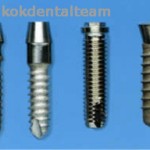
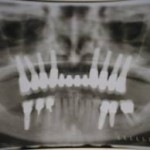
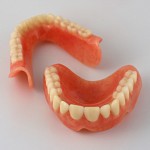
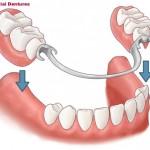 Partial Denture
Partial Denture